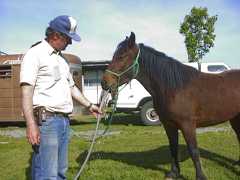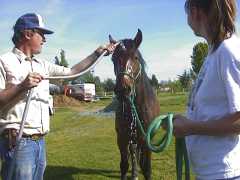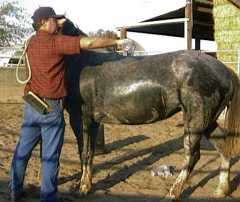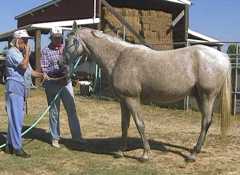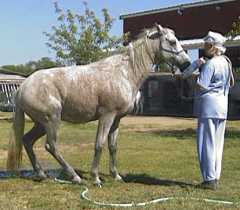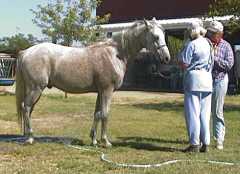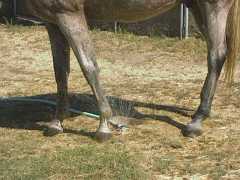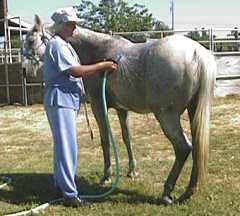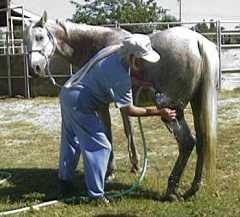Teaching your Horse to Accept a Bath |
|
Bathing a horse who doesn't want to cooperate can be a traumatic
experience that can often lead to the human becoming wetter than the horse
and the horse more firmly convinced than ever that bath time is
tantamount to a torture session. So how do you break the anti-bath cycle?
We use a number of approaches. First of all, we don't attack the horse with the hose and we try to make the bath as pleasant as possible. Generally a sweaty horse on a hot day likes to be cooled off. We may approach the horse with a bucket and sponge, starting by sponging the horse down, then by wringing water out of the sponge onto the horse, then by running the hose gently through the sponge while sponging the horse. Only after the horse is comfortable with what we have offered so far will we start to pour water directly from the hose over the horse. Some horses are very oral and we will let them drink from the end of the hose, then play the water on their faces. By returning to some occasional oral play, they will often allow you to move the water around on them. With others we find using water bottles for the first introduction to running water poured onto them. Still others can be pretty darn obstinate about having water applied on them. One such subject was Zodiac, which attenders of the Antioch Wild Horse Workshop will remember as the gray Arabian gelding who could give Aerial the Burro a run for her money when it came to stubbornness. Zodie was horrible to bathe. He hated being touched by water, would pull back at the wash stand and bathing was always a traumatic experience. This behavior pattern had gone on for years. Sharon suggested trying some clicker work with Zodie to see how he would respond. The results were most favorable. For the training Sharon used a relatively flexible garden hose, one of those stationary lawn sprinklers that has lots of little holes drilled in it, and a clicker target. Sharon played "Touch it!" a couple of times with a familiar target, then bunched up the hose, held it and had Zodie target the hose. Once he was unafraid of the hose, she put it on the ground, turned the sprinkler on low and had him touch his familiar target while moving closer to the sprinkler. In a short while he had the water running on his legs, then he was standing over the sprinkler. If Zodie got anxious about the water touching him, Sharon or Mary would simply refocus him on a handheld target. After a few minutes we could increase the water pressure and Zodie still stood calm. Eventually Sharon and Mary could actually pick up the sprinkler and wet Zodie down all over while he stood quietly on a loose line. Key Points When Teaching
|
Checking out the water hose
|
|
Important Note: If you take on the project of developing an untrained horse, everybody will want to give you advice. Don't act on any advice, including the ideas offered in this site, unless it makes sense to you and fits your individual situation. Your abilities and the sensitivities of your horse(s) may differ from the examples given. Be alert and rational with your actions so neither you nor your horse will get hurt. This information is offered as illustrations of what we do and the reader must apply common sense since he or she is solely responsible for his or her actions. Happy trails!Press "Back" to return to the page that brought you hereGo to Case Study SectionReturn to Training SectionReturn to Wild Horse MentorsReturn to KBR World of Wild Horses and BurrosGo To
| |

